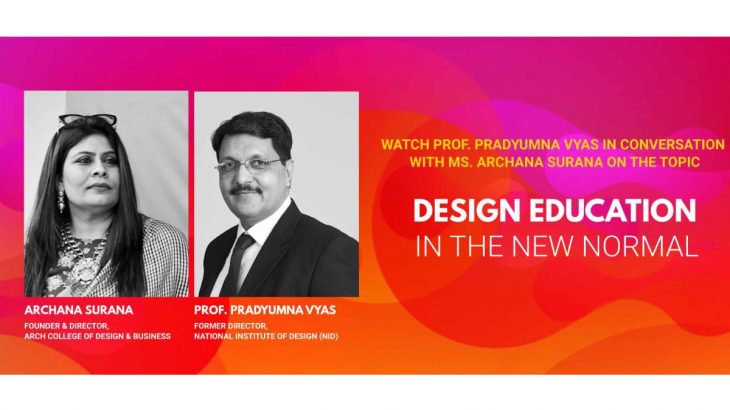In this amazing and innovating session, Archana Surana, Founder and Director, ARCH College of Design & Business converses with Prof. Pradyumna Vyas, Former Director of the National Institute of Design (NID) & an eminent Design Educator.
Prof. Vyas starts this conversation by throwing some light on the history of design education in India. The infrastructure of the entire world is currently in the fourth revolution. The prevalence of design started in the period when the world was in the middle of the second industrial revolution. While the third industrial revolution paved the way for digitalization and IT throughout the world, the fourth industrial revolution is merging all the different fields like IT, Biology, Commerce, Design, and others to come together as a new stream. While it is a known fact that Technology, Management, and Design, three of these branches in Indian education started together but the condition of the Indian economy during the 1960s did not allow Design to flourish as a strong individual field.
A couple of decades back, there was an acute shortage of designers in the country. This is where more and more design schools started functioning in the country. The National Institute of Design believes in merging together various branches of education such as Sociology, Anthropology, Technology, and Art together in their design curriculum.
In current times, Design education has become very relevant. Ever since our country started to focus on producing mass-produced goods with the help of designers for the sake of consumption and to keep the industry running, and for increasing GDP, it led towards major ecological damage. Design education is driven by the industry while it should run the other way round. When you say that you are working for the industry, your purpose gets defeated because the industry runs on money. If you work according to the industry, you will merely end up following what they ask you to do or make. This is not design education, a designer’s job is to tell the industry what is correct for it instead of merely taking orders or following the industry.
NID believes in training graduates so that they can ascertain what is correct for the industry instead of following what the industry asks them to do so.
With COVID, there has been a huge change in the mindset and the behavior of consumers from all over the world. The current times have allowed nature to get free while trapping humans inside their homes like a zoo. We need to understand that the environment will take care of itself but this situation has been caused by us. There will be a complete shift in the mindset of the consumers in the new normal. India is still in a better place because of its co-existence with nature.
The young generation is currently undergoing a mindset shift from “I” to “We.” Even now we see a lot of established designers who churn out big collections but do not mention the names of the craftspersons behind the same. This is one instance where the entire value system of design gets damaged. It is time for co-creation. Design has the power to lessen the gap between the rich and the poor in India.
Mahatma Gandhi’s concept of handwoven and handspun Khadi was an example of a beautiful concept in itself and it led each person to be empowered with the help of a loom within the spaces of their own home.
If we start to think clearly and seek prevention, we can save a lot of money from going into the healthcare system and live with wellness. Prof. Vyas believes that the well-being industry is going to be very very strong in the future.
The young generation that is Techno Savvy has the power to set up their own enterprise anywhere in the world. As a young person, if you have an aptitude for design, then try to become an excellent designer instead of being a mediocre designer. School education often disrupts out-of-the-box thinking in children. Design education allows you to deal with creativity and explore on your own while engineering education does not allow being open to ambiguity. Technology should not come before the creation of concepts. One should create a concept and then choose which technology to go for.
“Technology should follow the design, the design should not follow technology.”
